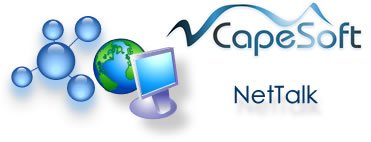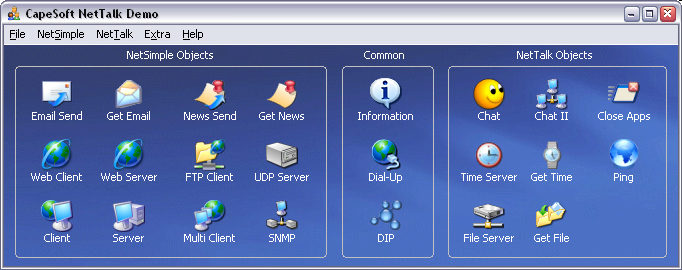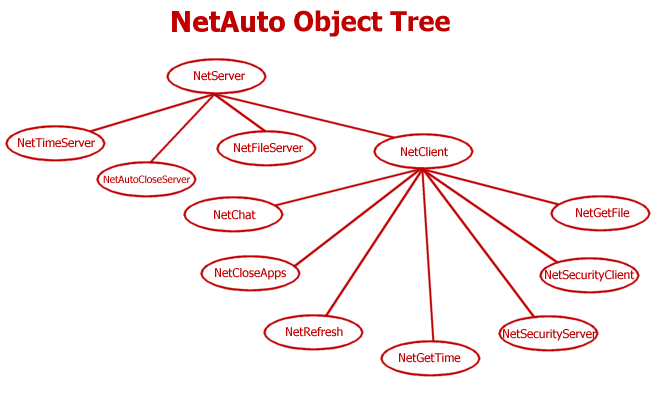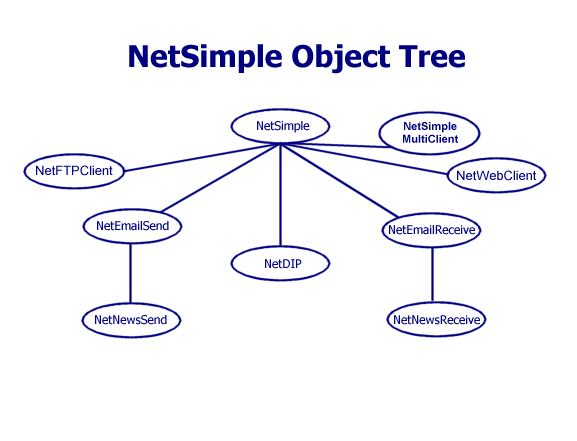

| Introduction | This section will help you find out what NetTalk offers and it describes the difference between the NetAuto and NetSimple classes. |
| Class Overview | A key place for quickly finding help on the different NetAuto and NetSimple objects. |
| Definition of NetAuto "Server" and "Client" | A good concept definition that is essential for you to grasp before you tackle network applications. |
| Using NetTalk in your application | A very good guide as to which classes you should use. |
| Examples | We've also packaged an excellent selection of examples with NetTalk. You may often want to read the documentation in conjunction with these examples, that are found in your Clarion/3rdParty/Examples/NetTalk folder. |
| Debug and Logging Section
Error Messages FAQ |
This section will help you debug your code. We've also added an error messages and a FAQ (Frequently Asked Questions) section. |
| Support | If you need support please check this section first to guide you through the getting support procedure. |
 |
Keen to get started? Then Jump Start sections are just for you - the basics on how to get NetTalk into your application as quickly and simply as possible. |
| Jump Starts | |
|---|---|
NetSimple Classes |
|
| Sending Emails | For sending emails. |
| Receiving Emails | For receiving emails. |
| Web Clients | For adding Web Client functionality (i.e. Download files or web pages) using HTTP or HTTPS (Secure HTTP). |
| FTP Clients | For FTP Client functionality (get directories, put or get files) |
Learning How to Use NetAuto |
|
| Scenario One | Single packet NetAuto Client/Server |
| Scenario Two | Broadcasting packets NetAuto Client/Server |
| Scenario Three | Multiple packets NetAuto Client/Server |
NetAuto Classes |
|
| Chat Controls | For adding the Chat Controls to your application to create a simple text chat application. |
| Close App Controls | For adding the Close App Controls to your application to allow your application to be shut down remotely. |
| DIP | For adding the NetDIP (Dynamic IP Management) functionality into your application. This will let your application run in "server" mode even though the IP of your machine may change or may be unknown to your clients. Particularly useful for WAN or Dial-Up. |
| NetRefresh | For adding the NetRefresh functionality to your application. NetRefresh allows your browses to automatically refresh when someone else (on another machine) updates data. |
| Use Remote Machine Controls | For adding the UseRemote control template to your application. (More advanced). |

NetDemo Application
| Examples | |||
|
Folder |
All examples in Clarion/3rdParty/Examples/NetTalk |
||
| Demo |
Updated This is the classic NetTalk demo application. It demonstrates the chat, Internet use, time transport, file transfer, auto close, client socket connections (NetSimple), listening server ports (NetSimple), Email send and receive, News send and receive, DIP (Dynamic IP) management, FTP, Web Client, Web Server, Ping and more. Note: This application uses HyperActive. If you do not have hyperactive you will receive a warning the first time you open the application saying "Unknown template type GloHyperActive(HyperActive)". Click OK a couple times and the application will run without HyperActive. This is not a problem. This example is the free demo that is available in an EXE at www.capesoft.com. |
||
|
|
|
||
| Scenario One | This is
scenario one.
|
||
| Scenario Two | This is
scenario two.
|
||
| Scenario Three | This is
scenario three.
|
||
| NetAuto File Get | A simple example of File Transfer using the NetFileServer and NetGetFile classes. It's even more simple than the example in NetDemo. | ||
| NetAuto File Get And Put | An example of using File Transfer to Put Files and Get Files. | ||
| NetRefresh | This is a simple example of
NetRefresh working. |
||
| Server DIP | This is source code for the
DIPServer. It requires the CapeSoft
WinEvent and looks better if you use CapeSoft's
HyperActive template. It's an example but can be used to run a DIP Server.
If you require the DIPServer.exe please download it from the NetTalk download page at www.capesoft.com . For more info on the DIP (client) class please look at the DIP class section. Note: If you are compiling in C55, please open the application (which will convert it from C5), Generate All, then remove the C5ASC%%L%.LIB in the Project Editor (Press the Project button). Then recompile. Note: If you are compiling in C60, please open the application, Generate All, then remove the ASCII drive from the Project Editor. Then recompile. |
||
| Server AutoChat |
This is the Automatic Chat
Server (Arnold) that runs the whole time at
CapeSoft. It's the Server that responds to the
Internet Chat part of the netdemo.app Requires WinEvent. |
||
| NetOptions | An example of how to use the
NetOptions
method call. (Includes reading and setting the Ports, NetName, Max Instances,
HostName & IP address etc.) |
||
|
|||
| FTP Download Directory | This is the example of how to download all the files in a directory using
the FTP class. |
||
| FTP Jump Start | This is the example of the
JUMP
START
FTP code. |
||
| FTP Multiple Upload |
FTP Multiple File
Upload. |
||
| FTP Template | FTP Template example | ||
| LinkPoint Payment |
LinkPoint Credit Card Payment Example Requires a LinkPoint account (or a trial one), a LinkPoint Certificate (real or trial) and CapeSoft's xFiles. |
||
| NetSimple Jump Start |
NetSimple JUMP
START |
||
|
NetSimple Packet Boundaries & Encryption (Automatically and Manual) - Automatic is the recommended option. |
NetSimple
Client Server example of how to manage packet
boundaries. This can be a little bit confusing at
first, (that's why we made the NetAuto classes) but this example will show you how to do it. See
FAQ G2 for
more information about Packet Boundaries. This
example also demonstrates how to use the
NetDESencrypt and NetDESdecypt functions. |
||
| NetSimple Client & Server |
NetSimple Client Server Test. Uses
normal TCP/IP or SSL. |
||
| Web Jump Start | This is the example of the
JUMP
START
Web code. |
||
| Web Polling Agent |
This is a Web poll example of checking web sites |
||
| Web Strain |
This is a Web example of
looping quickly through web sites |
||
| Web Server |
Removed This example has been replaced by the
NetWebServer and _NetWebServerWorker objects. See the NetDemo application for an
example of this. |
||
| Web Server In Memory - Connection Checker. |
This is an example of creating web pages in memory. Normally you would have web
pages on disk, but that not always necessary. This example requires
Clarion 6.1, SelfService and WinEvent (as well as NetTalk of course). This app will check a TCP/IP connection, and will send you an email if the port can not be reached. Useful for checking: - network route reachability, - if an application is still running - or if a machine is running (try using port 139) |
||
| Email Send Jump Start | This is the example of the
JUMP
START
Email Send code. |
||
| Email Send in a Process | This is an example of sending an email from
within a process. (In the "SendEmail in
a Process" folder). |
||
| Email Send PDF Report | This is an example of emailing an PDF Report generated by
PDFXChange. See
the details in the PDFXChange section.
(Note you need Tracker Software's PdfXChange (www.docu-track.com)
template to run this example.) |
||
| Email Receive Jump Start | This is the example of the
JUMP
START
Email Receive code. |
||
| Email Receive with Don't Download Again Option | This is the NetDemo.app's
TestEmailReceive window, with an
xFiles object to
save the self.EmailsDoneBeforeQ to an xml file so that this queue persists. |
||
| Server DIP | This is source code for the
DIPServer. It requires the CapeSoft
WinEvent and looks better if you use CapeSoft's
HyperActive template. It's an example but can be used to run a DIP Server.
Requirements: This requires WinEvent, NetTalk & HyperActive to compile correctly. You can get away without HyperActive, but you will definitely need WinEvent. If you require the DIPServer.exe please download it from the NetTalk download page at www.capesoft.com . For more info on the DIP (client) object please look at the DIP object section. |
||
| SNMP Jump Start |
SNMP
JUMP
START |
||
| Proxy | This is an example of using NetSimple to create a
Debugging Proxy Tool.
Documentation can be found in the separate NetTalk Proxy Document. Requirements: This requires WinEvent, NetTalk & HyperActive to compile correctly. You can get away without HyperActive, but you will definitely need WinEvent. If you require the proxy.exe please download it from the NetTalk download page at www.capesoft.com |
||
| Web Builder Email Send | This is an example of using
WebBuilder
and NetTalk. (Clarion 5.5 upwards). This example is not included in the NetTalk download, and must be downloaded separately from the NetTalk download page at www.capesoft.com . |
||
|
|||
| DialUp Jump Start | This is the example of the
Dial-Up JUMP
START
DUN code. |
||
| DialUp Hand Code |
This is an example of hand coding the Dial-Up object. |
||
|
|||
| Multi DLL ABC | Multi-DLL example
ABC application. This is just an example of how to use
the NetTalk templates if are building a multi-DLL application. |
||
| Multi DLL Legacy | Multi-DLL example
Legacy application. This is just an example of how to
use the NetTalk templates if are building a multi-DLL application. |
||
| Multi DLL Legacy Email | Multi-DLL example
Legacy
application using Email. |
||
|
|||
| Legacy | NetLeg.app - This is a Legacy example.
|
||
| Legacy | LegEmail.app - This is a
Legacy
example application. If you use the Secure Email Sending, please ensure you
include the SSL DLLs (see the
Distribution section for details) in the application folder. |
||
| Multi DLL Legacy | Multi-DLL example
Legacy application. This is just an example of how to
use the NetTalk templates if are building a multi-DLL application. |
||
| Multi DLL Legacy Email | Multi-DLL example
Legacy
application using Email. |
||
|
|||
| Proxy | This is an example of using NetSimple to create a
Debugging Proxy Tool.
Documentation can be found in the separate NetTalk Proxy Document. |
||
Global Templates |
||
| Activate_NetTalk | This Global Template must be added to your application to use any of the following features. | |
| Use_NetRefresh | Add this Global Template to use NetRefresh in your application. | |
Control Templates |
||
| ChatControls | This control template quickly adds all the chat controls to your window. | |
| CloseAppControls | This control adds the controls for closing down your application remotely. | |
| SendEmailControls | This adds basic controls for sending email. For more functionality you will need to use the NetSendEmail class directly. | |
| UseRemoteMachine | Adds the controls to connect to remote machine on a WAN or the Internet. Most people will probably rather use the NetDIP class to do this now. | |
NetAuto Classes |
||

|
NetServer NetClient |
The Main NetAuto classes. These provide you with the greatest degree of flexibility when using the incredibly robust NetAuto protocol. | |
|
NetAutoCloseServer NetCloseApps NetChat NetGetFile NetFileServer NetGetTime NetTimeServer NetRefresh |
Specific classes based on the NetAuto technology (NetServer & NetClient). Some of these classes can be included into your application using Control Templates or Extension Templates. | |
| NetSecurityServer NetSecurityClient |
These are unsupported at the moment, but will form joint functionality with CapeSoft's Secwin product to provide licensing control to applications. | |
NetSimple Classes |
||

| NetSimple | This class allows you to establish client socket connections to another server, or to behave like a server and listen on a port for incoming connections. | |
| NetSimpleMultiClient | This class allows you to establish multiple clientsocket connections to another server. | |
|
NetEmailSend NetEmailReceive |
These classes allows you to send and receive email. | |
|
NetNewsSend NetNewsReceive |
These classes allows you to send and receive news. | |
| NetDIP | This class provides Dynamic IP Management to your application. This class allows you to connect to a DIP server, which will tell your application instance about all the other people running your application. | |
| NetFTPClient | These two classes (NetFTPClientControl & NetFTPClientData) allow you to build FTP clients to connect to FTP servers and download and upload files. | |
| NetWebClient | This class allows you to connect to web servers and download pages as well as posting data to web page forms. |
NetDUN This class allows you to add Dial-Up Networking to your application.
| CapeSoft Sales | |
|---|---|
| Web | www.capesoft.com |
| Telephone | +27 87 828 0123 |
| Fax | +27 21 715 2535 |
| Post | PO Box 511, Plumstead, 7801, South Africa |
| Buy Online | |||
|---|---|---|---|
| New product | ClarionShop | ||
| Upgrade to NetTalk 6 | ClarionShop | ||